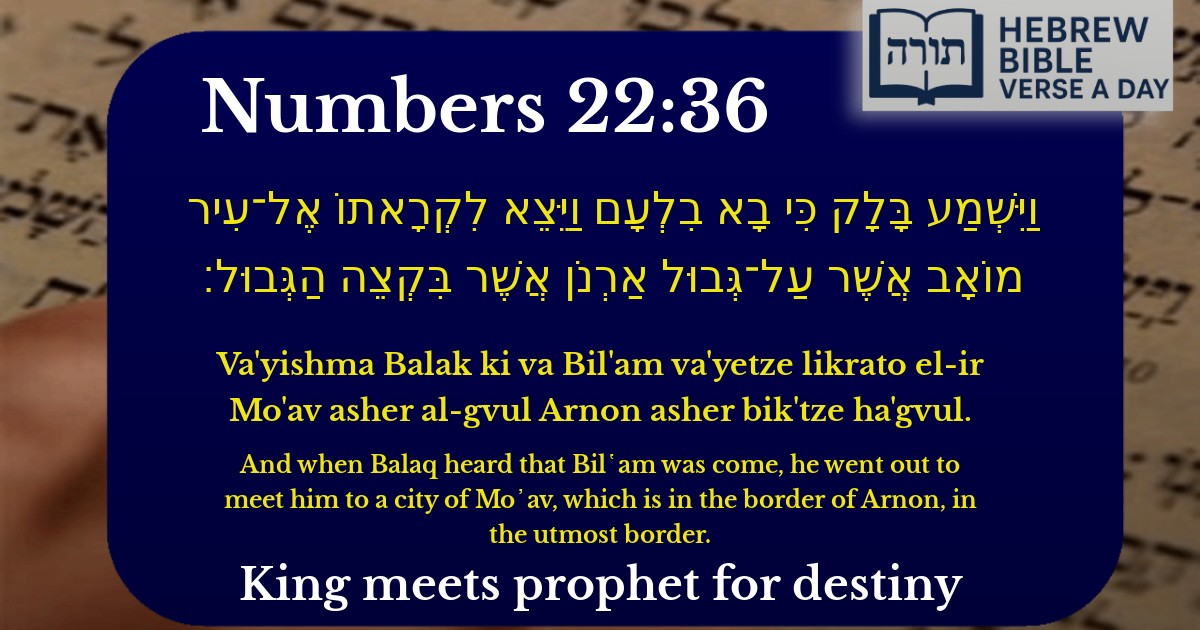Join Our Newsletter To Be Informed When New Videos Are Posted
Join the thousands of fellow Studends who rely on our videos to learn how to read the bible in Hebrew for free!
Hebrew Text
וַיִּשְׁמַע בָּלָק כִּי בָא בִלְעָם וַיֵּצֵא לִקְרָאתוֹ אֶל־עִיר מוֹאָב אֲשֶׁר עַל־גְּבוּל אַרְנֹן אֲשֶׁר בִּקְצֵה הַגְּבוּל׃
English Translation
And when Balaq heard that Bil῾am was come, he went out to meet him to a city of Mo᾽av, which is in the border of Arnon, in the utmost border.
Transliteration
Va'yishma Balak ki va Bil'am va'yetze likrato el-ir Mo'av asher al-gvul Arnon asher bik'tze ha'gvul.
Hebrew Leining Text
וַיִּשְׁמַ֥ע בָּלָ֖ק כִּ֣י בָ֣א בִלְעָ֑ם וַיֵּצֵ֨א לִקְרָאת֜וֹ אֶל־עִ֣יר מוֹאָ֗ב אֲשֶׁר֙ עַל־גְּב֣וּל אַרְנֹ֔ן אֲשֶׁ֖ר בִּקְצֵ֥ה הַגְּבֽוּל׃
Parasha Commentary
📚 Talmud Citations
This verse is not quoted in the Talmud.


Context of the Verse
The verse (Bamidbar 22:36) describes King Balak of Moab's reaction upon hearing that Balaam had arrived. Balak went out to greet Balaam at a Moabite city on the border of the Arnon River, which marked the extreme boundary of Moab. This event occurs during the Israelites' journey toward the Promised Land, when Balak seeks to curse them through Balaam's divination.
Rashi's Commentary
Rashi (Rabbi Shlomo Yitzchaki) explains that Balak went to the furthest border of Moab to meet Balaam, emphasizing his eagerness and desperation. Rashi notes that Balak's actions reflect his fear of the Israelites, as he sought supernatural means to weaken them rather than confronting them militarily. The location—Arnon's border—was significant because it was the site where Moab had previously suffered a military defeat (as alluded to in Bamidbar 21:26-30), heightening Balak's anxiety.
Midrashic Insights
The Midrash (Bamidbar Rabbah 20:7) elaborates that Balak's choice to meet Balaam at the border was strategic. Since Balaam was coming from Aram, Balak intercepted him before he could enter Moab proper, ensuring that Balaam would not see the Israelites' camp from within Moabite territory. The Midrash suggests that Balak feared Balaam might sympathize with the Israelites if he observed their orderly encampment (as described later in Bamidbar 24:2-5).
Rambam's Perspective
Rambam (Maimonides) in Moreh Nevuchim (3:41) discusses Balaam's unique prophetic status among non-Jews. He explains that Balak, aware of Balaam's reputation, believed in the power of curses and blessings uttered by a diviner. Thus, Balak's journey to the border underscores his superstitious reliance on Balaam's abilities, despite the Torah's later affirmation that Hashem controls all outcomes (Bamidbar 23:8).
Symbolism of the Border